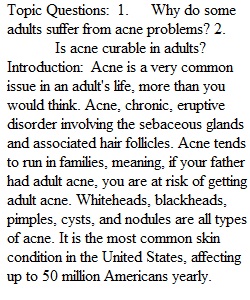


Q Introduction: The Anatomy of a Research Project will introduce you to the EGCC Library, its resources, and the basic research process. In this assignment, you will work through the research process and complete each of the steps without actually writing the research paper. At the end of this assignment you will submit: 1. A clearly defined thesis statement with 2-3 accompanying research questions. 2. An annotated bibliography of sources you found and a summary paragraph of your research process. 3. A basic outline of your “research paper”. 4. A draft of your introductory paragraph that includes your thesis statement. Instructions: First time users and those unfamiliar with the EGCC Library and Information Commons should view our Introduction to the Library guide: https://egcc.libguides.com/libintro (Links to an external site.). Library login information can be found here: What is my EGCC Library username and password?: https://egcc.libanswers.com/faq/298490 (Links to an external site.). Students should refer to the Library’s Getting Ready for Research: https://egcc.libguides.com/c.php?g=1034023 (Links to an external site.) guide for information and tips on the research process (this guide includes much of the information you need to complete this assignment, like, what is an annotated bibliography). Step 1: Choose a research topic (this can be a recent news topic or some other researchable topic of interest to you). Tip: For a quick pick topic, see this FAQ: https://egcc.libanswers.com/faq/326821 (Links to an external site.) Once you have chosen a researchable topic, frame your topic into several questions that you would like to answer. Example: You choose child labor as your topic. Some potential research questions could be: What laws govern child labor in the United States? or At what age do minors stop being covered by child labor laws? These questions can guide your research. You will also use your questions to create your search terms. See Getting Ready for Research- Research Basics and Planning: https://egcc.libguides.com/getting_ready_for_research (Links to an external site.) for tips on choosing search terms. Bonus Tip: If you still have difficulty choosing a topic, consider looking in these databases for some additional options: Points of View Reference Center, Very Short Introductions, and TOPICsearch. Visit our A-Z Database List (https://egcc.libguides.com/az.php (Links to an external site.)) to access them. Watch: 1. Research Process Overview video (covers choosing topic, searching, and thesis statement):https://youtu.be/u7haY-9T5bw (Links to an external site.) 2. Topic Choice: https://youtu.be/0yEHgdwBhcE (Links to an external site.) ; 3. How to Broaden or Narrow a Topic:Variations on Topics or, To Broaden or to Narrow (Links to an external site.) Step 2: Write a thesis statement for your research project Write a thesis statement (the statement that you are trying to prove or disprove) for your research paper or presentation. Watch: Writing a Thesis Statement tutorial videos: 1. EGCC Library:A Question is Formed and a Thesis is Written (Links to an external site.) 2. Credo Ref:https://youtu.be/OD8NU-fqHf0 (Links to an external site.) Step 3: Searching, Evaluating, Summarizing 1) Use your search terms from Step 1 and find four to six potential information sources. 2) Evaluate these resources and create an annotated bibliography for your research project. 3) Write a paragraph summary of your research process. In your summary, note any techniques you used, ways you found your resources or problems you encountered. Tip: See the following guides for useful information on the library website, searching the library databases and creating an annotated bibliography: • Introduction to the Library: https://egcc.libguides.com/libintro (Links to an external site.) • Getting Ready for Research - Research Resources: https://egcc.libguides.com/getting_ready_for_research/resources (Links to an external site.) • Annotated Bibliography: https://egcc.libguides.com/getting_ready_for_research/annotated_bibliography (Links to an external site.) Note: Your research should include some sources from the library’s research databases; but, depending on your topic, it may also include sources from government websites, professional associations, news publications, or the open internet. Watch: • Searching and Organizing:Beyond Questions and Theses (Links to an external site.) • Search Terms:My Subtopic Has Search Terms for Me (Links to an external site.) Step 4: Outline your research paper or presentation Compose a brief outline for your research paper or presentation. Your outline should include the following elements as brief statements: 1. Intro with thesis statement 2. List the major points of your thesis 3. List the supporting ideas and arguments for each major point 4. Conclusion Tip: Purdue OWL includes many fantastic tutorials and examples, here’s one on outlining a paper: https://owl.purdue.edu/owl/general_writing/the_writing_process/developing_an_outline/how_to_outline.html (Links to an external site.). Step 5: Write the opening paragraph of your paper. Compose the opening paragraph for your research paper or presentation. This paragraph should include your thesis statement. PreviousNext
View Related Questions